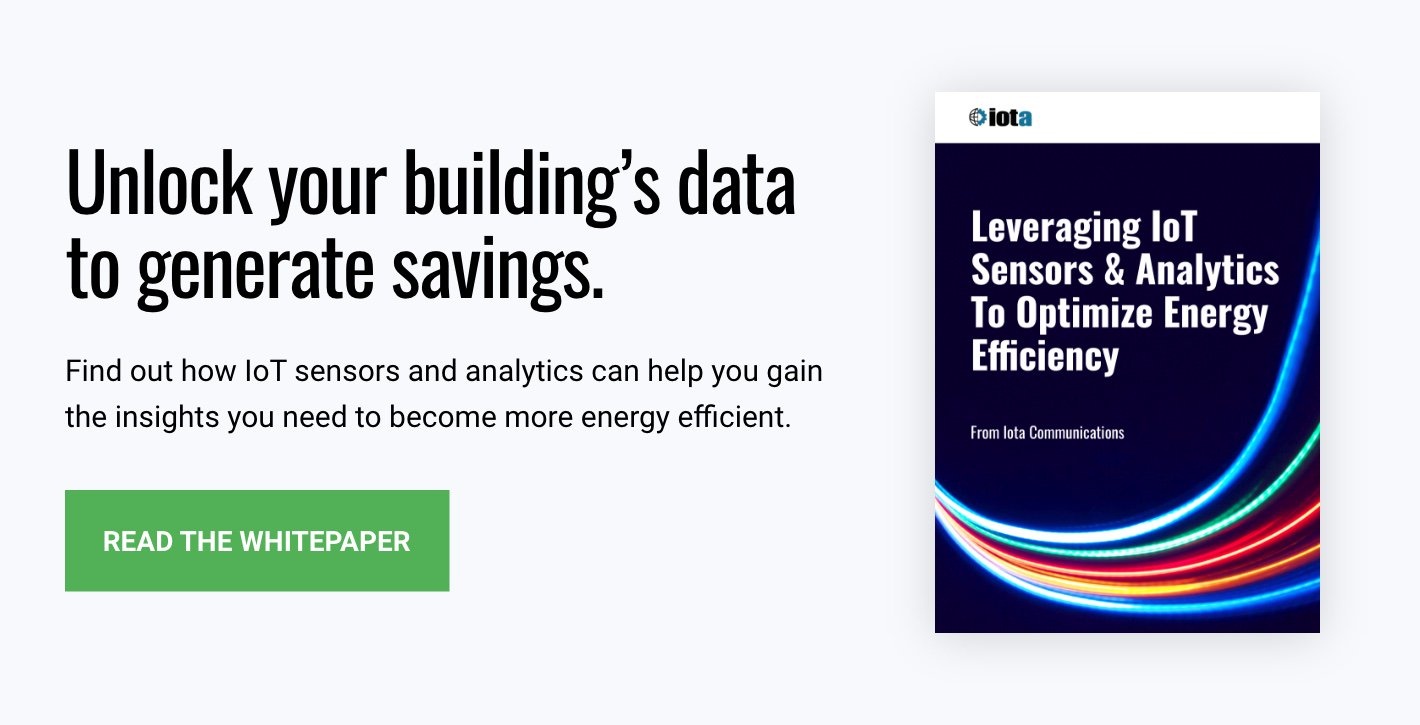If you own or manage a building that’s been around a while—whether it’s a school, hospital, manufacturing facility, retail store, office building, or any other physical space—it’s safe to assume that it’s not as energy-efficient as it could be. Commercial buildings have been found to waste, on average, 30% of the energy they consume; unless you’ve taken steps to address this loss (other than using a traditional building management system—or BMS), your efficiency rate likely isn’t far off.
But what about new construction? Today, there are more ways to “bake in” energy management tools from the start that afford better control over energy use—one of which is a building energy management system (BEMS).
How does BEMS compare to traditional building management systems? Are these two systems representative of the latest that technology has to offer? If you’re investigating the latest, most effective ways to handle energy management in new or existing buildings, you’re in the right place. In this article, we’ll explain your options, from traditional building management systems to BEMS to the Internet of Things (IoT). We’ll also try to clarify the future direction of the industry, so you can put your building in the best position to optimize all facets of your building operations—energy, air, and water—going forward.
Download our white paper to read about two of the most impactful IoT strategies commercial buildings are implementing today to achieve energy efficiency.
Building Energy Management Systems & More: What’s available?
Building Management Systems (BMS)
Most buildings have some type of building management system—also known as a building automation system (BAS)—in place to help manage the facility. When the concept of a BMS was first introduced years ago, these computer-based systems were a game-changer: They gave facilities managers one central system through which they could monitor and control all building operations, from lighting and HVAC to security systems and elevators. A BMS also makes it possible to automate operations to some extent, such as scheduling lights or heating systems to turn on and off at certain times. Overall, using a BMS is likely to produce greater energy savings compared to not using one simply because it provides the easy access and control necessary to operate more cost-efficiently.
Many existing buildings continue to rely solely on BMS as a tool for energy management. However, while BMS is still an effective way to control building environments, it has limited capabilities and can’t provide much value beyond simple scheduling and automation. If your commercial building only has a BMS, consider pairing it with an Internet of Things (IoT) solution (see below) for a more advanced energy management strategy.
Building Energy Management Systems (BEMS)
In the years since the introduction of the BMS, another important application for commercial buildings has emerged with regard to energy efficiency: building energy management systems.
Although BEMS is very similar to BMS, BEMS is a slightly more sophisticated energy management system for commercial buildings. A BMS provides the ability to monitor all systems and control them centrally; BEMS provides monitoring and information specifically focused on systems involving energy use and demand that facilities managers can then act upon to create savings.
For example, if a utility calls a demand response event, a BEMS can receive that external signal from the utility and send control instructions to building systems in response. To reduce the overall load, BEMS may direct lights to dim in certain areas, increase the temperature set point, and/or shift from utility generation to a battery storage system. BEMS are also capable of monitoring, aggregating, and processing data at a basic level to inform logic-controlled responses. Yet, while BEMS are useful, they are still primarily used in a reactionary manner to address issues after the fact. Rarely do organizations use them in such a way that would be useful for predicting and optimizing future building performance.
The more advanced functionality of BEMS does make it a better choice for new construction than BMS. However, the future of energy management in buildings is heading away from these traditional systems and toward the more innovative IoT-based energy management platforms.
IoT-Based Analytics Platforms: Building Energy Management Solutions For The Future
IoT-based analytics platforms are the latest evolution in energy management for commercial buildings. More than a control system since the IoT actually complements traditional building management systems, an IoT-based platform gives facilities managers an unprecedented level of insight into their building systems, allowing them to proactively control operations, as well as the overall building environment. Knowing where, when, and how their building is consuming energy allows facilities managers to adopt load-shedding schedules to reduce energy demand (and thus utility costs) actively and strategically.
Using wireless IoT sensors placed throughout your building, you can collect real-time, detailed information about your commercial building’s energy consumption. These sensors can monitor various operations remotely, including:
- Individual machinery
- Lighting
- HVAC
- Ventilation systems
- Refrigeration units
- Hot water systems
- Heat pumps, and more
IoT-based platforms are not only capable of monitoring and measuring various aspects of your building but also bringing in various other data inputs to extrapolate anomalies, make correlations, and help end users gain knowledge to make smart operational decisions that will affect the bottom line. Depending on your goals and the specific strategies you’re employing, some of the data inputs that will lead to insights include:
- Total energy consumption of systems and equipment connected to the electrical network. Some of your systems are always operational; other pieces of equipment and machinery may be connected only occasionally. Either way, it’s crucial to understand both the total daily electrical consumption of your building and the role individual devices play in your overall energy use.
- Occupants’ behavior. Activity levels, behavior patterns, and comfort preferences of occupants may be a consideration for all energy efficiency measures (and for all types of buildings), but they are a more significant factor for certain types of buildings and saving strategies.
- Energy usage patterns. Knowing when and how your building uses energy—and attempting to reshape those patterns to your advantage—are key components of some cost-reduction strategies (see demand response below).
- Utility time of use charges. Shifting your energy use away from high-priced time periods set by utility companies is a common way to generate savings. IoT-based platforms can help identify periods where energy costs are the most expensive.
- Cyclical or seasonal factors. Over time, your building’s energy consumption may follow predictable change patterns that an IoT-based analytics platform can take into consideration when generating proposed solutions.
- Weather data. Weather conditions can have a direct impact on energy use, specifically as they relate to HVAC systems. Collecting, compiling, and analyzing weather data in connection with other building information allows you to be proactive about HVAC energy consumption on especially hot or cold days.
With the right data variables—collected, correlated, and analyzed by the IoT—it’s possible to design your building’s optimal approach to energy management for guaranteed cost savings. The reason this IoT-based strategy is so much more effective for energy management than traditional BMS and BEMS is because the energy consumption of a commercial building is continuously changing based on a number of dynamic conditions—there is no static model of energy use. Better energy management, then, relies on having the right data at the right time, which allows building managers to be flexible and agile in their approach to energy reduction.
Holistic Building Management—Energy, Air, & Water
For many facilities managers, the primary goal of a building management system is to generate energy cost savings. Both BMS and BEMS aren’t capable of monitoring and measuring certain components—CO2 level, air temperature, humidity, luminosity, water temperature, and conductivity—that often play a critical role in using energy more efficiently. (Read about one such energy-saving strategy here.) IoT data collection and analysis that includes these factors will produce better long-term results.
These days, sustainability goals and even COVID-19 safety precautions are becoming equally important to (if not more than) lowering utility bills. Many IoT-based platforms work just as well for managing building air quality and water use as they do for managing energy consumption. Choosing an IoT-based platform not only puts you in the best position for achieving your short-term goals, whatever they may be, but also sets you up for better building management across all areas in the future.
Are you looking for a building energy management system—or an IoT partner who can help you better manage your entire building?
If you’re looking for a basic energy monitoring and control system, BEMS might be the right choice for you. If you’d rather learn about a different approach to building management—one that’s IoT-based and uses advanced analytics to help you control every aspect of your building—then talk to us at IotaComm™.
Our IoT solutions can be deployed on a small scale and are retrofittable and cost-effective, giving you the exact data you need for energy management throughout your building. You can be up and running quickly—you’ll have data to review in just days—and we’ll help you interpret the analysis produced by our platform and make recommendations for improvements.
Whether you’re interested in saving money on energy, increasing your sustainability, creating cleaner air, using water responsibly—or all of the above!—we can help. Tell us about your goals, and we’ll talk about how we can best partner up to reach them.


